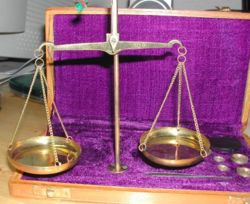7. Klasse:Algebra:Gleichungen 2: Unterschied zwischen den Versionen
Aus DMUW-Wiki
K |
K |
||
| (3 dazwischenliegende Versionen von einem Benutzer werden nicht angezeigt) | |||
| Zeile 1: | Zeile 1: | ||
| + | <div style="border: 3px solid #551A8B ; background-color:#CD96CD ; padding:7px;"><big><span style="color:#551A8B ">'''Gleichungen</span>'''</big></div> | ||
| + | <br /> | ||
{| | {| | ||
|- | |- | ||
| Zeile 179: | Zeile 181: | ||
<br> | <br> | ||
<br> | <br> | ||
| − | <div align="left">[[Aufgabentypen/Geometrie: | + | <div align="left">[[Aufgabentypen/9. Klasse:Geometrie:Flächensätze am rechtwinkligen Dreieck_3|<math>\Rightarrow</math> Weiter zur nächsten Aufgabe]]</div> |
<br> | <br> | ||
| − | <div align="left">[[Aufgabentypen/Geometrie: | + | <div align="left">[[Aufgabentypen/9.Klasse:Geometrie:Flächensätze am rechtwinkligen Dreieck|<math>\Leftarrow</math> Zurück zur vorherigen Aufgabe]]</div> |
Aktuelle Version vom 17. Juli 2009, 14:17 Uhr
Gleichungen
|
Wie bei einer Waage müssen beide Seiten der Gleichung immer im Gleichgewicht sein. Dies erreichst du durch Äquivalenzumformungen, mit denen du beide Seiten der Gleichung einheitlich umstellst, ohne dass sich der Wert der Gleichung ändert. |
Wende diese Regel nun auf die folgenden Aufgaben an. Beachte immer die Grundmenge, die rechts steht.
Wenn du dir sicher bist, welche Äquivalenzumformung als nächstes kommt, darfst du durch Markieren des grauen Feldes den jeweils nächsten Schritt sichtbar machen!
Erst ganz am Ende kannst du dann dein Ergebnis durch Klick auf "Lösung anzeigen" überprüfen.
- Beispiel :

- 3x + 10 = 19

- 3x + 10 = 19 | - 10
 3x = 9 | : 3
3x = 9 | : 3
 x = 3
x = 3
- 9x - 18 = 27

- 9x - 18 = 27 | + 18
 9x = 45 | : 9
9x = 45 | : 9
 x = 5
x = 5
- 12 - 12 : 12 = 2x + 2 : 2

 12 - 1 = 2x + 1 | - 1
12 - 1 = 2x + 1 | - 1
 10 = 2x | : 2
10 = 2x | : 2
 x = 5
x = 5
- 23 + 32 = 5x + 17

 8 + 9 = 5x + 17
8 + 9 = 5x + 17
 17 = 5x + 17 | - 17
17 = 5x + 17 | - 17
 0 = 5x | : 5
0 = 5x | : 5
 x = 0 ... wirklich?
x = 0 ... wirklich?
- 3x + 8 + 6x - 3 = -13

 9x + 5 = -13 | - 5
9x + 5 = -13 | - 5
 9x = -18 | : 9
9x = -18 | : 9
 x = -2
x = -2
- -3
 (3 - 2x) + 2x = -21
(3 - 2x) + 2x = -21

 -9 + 6x + 2x = -21
-9 + 6x + 2x = -21
 -9 + 8x = -21 | + 9
-9 + 8x = -21 | + 9
 8x = -12 | : 8
8x = -12 | : 8
 x = -1,5
x = -1,5


































 Weiter zur nächsten Aufgabe
Weiter zur nächsten Aufgabe Zurück zur vorherigen Aufgabe
Zurück zur vorherigen Aufgabe
